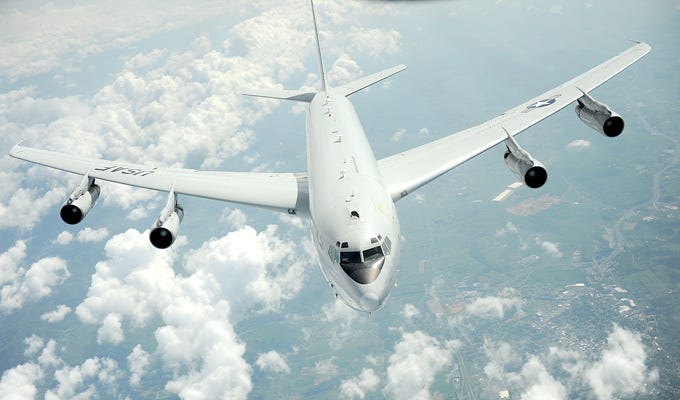Colin Gray has written prolifically and thoughtfully about airpower. Here’s a short lesson plan written for those who need to tune up their “elevator speech.”
Seminar on the Evolution of Airpower Theory
Modern Airpower Theorist: Colin Gray
This lesson examines the contributions to the theory of airpower by the recognized strategist Colin Gray. Gray provides a theory of airpower that includes the empirical lessons of its meandering maturity within joint warfare. His theory provides evenhanded advocacy, vice zealotry, for the enduring utility of airpower.
This is a 30-45 minute lesson.
An E-8C Joint STARS from the 116th Air Control Wing, Robins Air Force Base, Ga., pulls away, May 1, 2012, after refueling from a KC-135 Stratotanker with the 459th Air Refueling Wing, Joint Base Andrews, Md.
(Photo: MSgt. Jeremy Lock/USAF)
ENABLING LEARNING OBJECTIVES
1: Analyze the airpower theories of Colin Gray based on Winton’s model.
STANDARD: Analysis will include a comparison of Gray with other theorists discussed previously both in this course and the CGSC core history courses.
2: Analyze the typology of empirical errors in theory.
STANDARD: Analysis will include the extent limitations to Winton’s model.
3: Develop an understanding of the theoretical strengths and limitations of airpower that can be described to joint and coalition partners as well as policy makers.
STANDARD: Analysis must include airpower’s role in the “whole house of war.” Students should be able to articulate contextual principles for the utility of modern airpower in joint warfare.
 C-130J Hercules and WC-130J Hercules fly in formation during an Operation Surge Capacity exercise over the Mississippi Gulf Coast region April, 5, 2014.
C-130J Hercules and WC-130J Hercules fly in formation during an Operation Surge Capacity exercise over the Mississippi Gulf Coast region April, 5, 2014.
(Photo: Sr Amn Nicholas Monteleone/USAF)
HOMEWORK ASSIGNMENT
REQUIRED READINGS:
(1) Read: Gray, Introduction (pages ix — xii), Understanding Airpower: Bonfire of the Fallacies (pages 1 — 8), and America, The Air Power (pages 56 — 61), “Understanding Airpower: Bonfire of the Fallacies.” (16 total pages) http://aupress.maxwell.af.mil/digital/pdf/paper/ap_0005_gray_understanding_airpower.pdf
(2) Read: Individually assigned fallacy from Gray, The Fallacies, “Understanding Airpower: Bonfire of the Fallacies,” as required, pages 11 — 56. (~5 pages)
(3) Scan: Gray, Chapter 9, “Airpower Theory,” Airpower for Strategic Effect, pages 267 — 305 (especially 272 — 275). http://self.gutenberg.org/details.aspx?bookid=2170893
OPTIONAL READINGS:
(1) Knox and Murray, “Thinking About Revolutions in Warfare” and “Conclusion: The Future Behind Us,” The Dynamics of Military Revolution, 1300-2050.
(1) Unassigned fallacies from Gray, The Fallacies, “Understanding Airpower: Bonfire of the Fallacies,” pages 8 — 56.
(2) Gray, Chapter 3, Geographies of Warfare, Airpower for Strategic Effect, pages 57 — 82.
READING QUESTIONS
a. Throughout several of the fallacies, Gray uses the terminology ‘strategic effect.’ What does he mean by this terminology? What is net strategic effect?
b. Fallacy #1: What kind(s) of conflict, in terms of conventional, low-intensity, et cetera does Gray predict for the future? What does that mean for airpower?
c. Fallacy #2: Does Gray think that airpower is inherently strategic? How does he define “strategic?” How does he describe the doctrinal mission of ‘strategic attack?’
d. Fallacy #3: How does Gray refute that airpower is over reliant upon technology? To what extent does airpower rely upon technology? Tactics? Organization? Doctrine?
e. Fallacy #4: How does Gray’s theory of airpower contrast with Douhet, ACTS, Warden, and others? What makes airpower uniquely different from land- and seapower?
f. Fallacy #5: What contextual caveats does Gray make in his theory? According to Gray, which (geographic) forms of military power are ‘decisive?’
g. Fallacy #6: How does Gray’s “proper theory of airpower” inform strategies of warfare? What is he implying as the proper end of using airpower in warfare?
h. Fallacy #7: What does Gray think about “air-mindedness?” How would Gray describe and delineate the utility of the “four air forces” of the United States?
i. Fallacy #8: What evidence does Gray provide for the essential need for airpower in counterinsurgency warfare (COIN)? How holistic is Gray’s airpower theory compared to Douhet, Mitchell, and others?
j. Fallacy #9: How does Gray’s theory of airpower compare or contrast with the lessons of revolutionary change provided by Knox & Murray’s Dynamics of Military Revolutions in the CGSC core H100 history courses?
 Senior Airmen Brian Colt Gass monitors the air space and weather conditions around the Geronimo landing zone March 14, 2014, at the Joint Readiness Training Center, Fort Polk, La. (Photo: MSgt. John R. Nimmo/USAF)
Senior Airmen Brian Colt Gass monitors the air space and weather conditions around the Geronimo landing zone March 14, 2014, at the Joint Readiness Training Center, Fort Polk, La. (Photo: MSgt. John R. Nimmo/USAF)

No comments:
Post a Comment